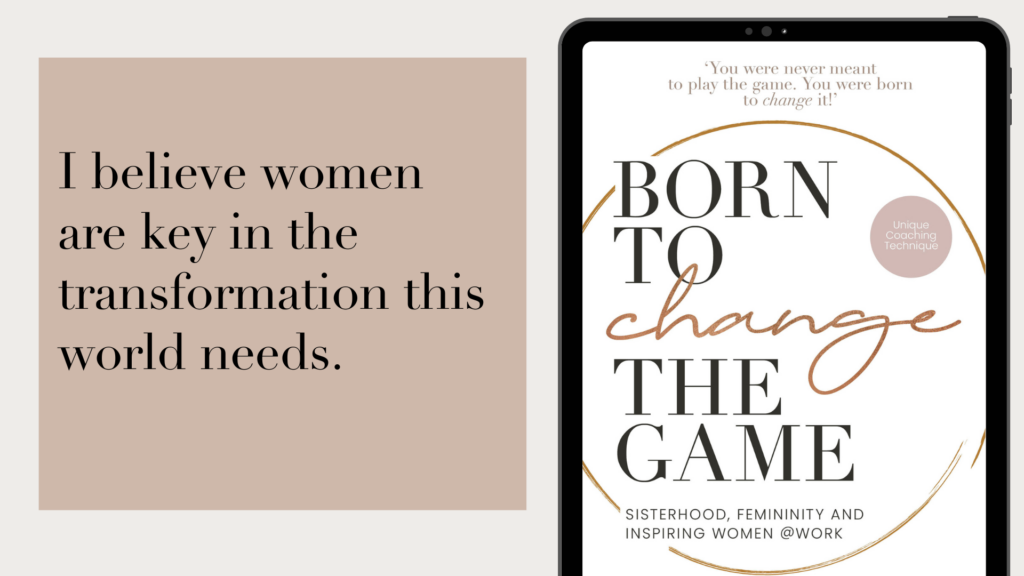Today’s female leader stops adapting and starts tuning in.
You’re good at what you do. You know what’s expected of you, you read space effortlessly, and you move confidently through complex decision-making. You have impact. You’re visible. And you get things done.
And yet, somewhere between that full schedule and all those expectations, it feels like you’ve lost something of yourself along the way. It gently creeps in at times when you are momentarily at a standstill.
On Sunday night when you’re sitting down to review the week ahead. When putting the kids to bed.
During a hike on vacation.
A feeling you usually quickly push away, fearing what it might evoke or overhype.
But it doesn’t want to overhype your life. It wants to deepen your life.
It is an inner invitation to stop adapting yourself to what is expected of you and start living and leading in alignment with what is in you. With your values. Your limits. Your desire. Your truth.
This feeling is not asking you to do even more. It is asking you to be still for a moment. To listen. To feel. To slow down.
So that your leadership is no longer a role you play, but becomes a living expression of your vision, your moral compass and the values you want to embed in your work and your organization.
What is authentic leadership and why is it so urgent?
When I talk about authentic leadership, I mean the ability to express your inner truth – such as your vision, moral compass, norms and values – in your leadership. This ability requires emotional competence: being able to deal in a mature way with pressure from your environment, and with feelings such as those of fear, uncertainty, and frustration.
We have become accustomed to leadership as something that takes place mostly in your head: analyzing, deciding, controlling. But in practice, your leadership is just as often determined by what happens in your body.
Think of that moment in a meeting when your breathing shoots up because someone unexpectedly challenges you. Or that your shoulders tighten when a decision is
taken that you don’t actually support. Or that your heart rate speeds up when you want to say something, but you’re unsure if it’s the right time.
These feelings are not a sign of weakness, but rather an entrance to your authenticity.
They invite you to ask: What is happening here that makes me feel I need to say or do something?
It’s about staying present to discomfort, rather than overpowering it. That you learn to listen to what is happening in your body, even before your head puts words to it.
Thus, leadership does not become a role you play, but something you embody.
And people feel that in your words, in your decisions, in the way you take up space.

Why women leaders grow by slowing down
When, as a female leader, you are constantly in top gear, you become unknowingly detached from yourself.
You function on routine and experience, but you feel less keenly whether something is really right. Maybe you recognize it:
- You say “yes” in a consultation while inside you feel “no,” because it seems more efficient to move along.
- You make decisions based on arguments that sound good, but that make you restless later.
- You keep going, even when you find that you are exhausted, because it doesn’t seem like the time to slow down.
In the short term this seems effective. But in the long run it is at the expense of your clarity, creativity and carrying capacity.
You lose alignment with yourself, and with that the power to make decisions that really suit you and what the situation demands.
Slowing down then is not a luxury, but a strategic choice.
It is the pause button you use to reconnect with your body, your emotions and your intuition.
It can be done in small moments:
- A breath before responding to a sharp question.
- Taking five seconds of silence in a conversation to really feel what you want to say.
- A short walk after a spirited meeting to release tension.
In those moments, you hear your own voice again.
You notice whether you react from habit or from attunement. You feel what is right and where your limit lies.
As Viktor Frankl puts it:
“Between stimulus and response there is a space. In that space is our power to choose our response. In our response lies our growth and our freedom.”
That space, that’s what slowing down provides.
And it’s exactly why in The Women’s Leadership Program we always start with slowing down. Not as a bonus, but as the foundation of your leadership.
Reflection as a leadership skill: the indispensable foundation
In many organizations, reflection is still seen as something you do only when things are quiet. A moment at the end of the year, armed with an evaluation form.
But for you as a leader, reflection is not an “extra. It is the foundation on which your decisions, relationships and results rest.
In my work, I call these micro-reflections: brief, intentional moments when you check in with yourself in the middle of the action.
They are mini-pauses of a few seconds in which you notice what is happening inside you and choose how you want to respond.
Consider:
- During a conversation, notice that your breathing goes up and pause for a moment to return to calmness.
- Feeling irritated and asking yourself what is really being hit.
- Finding out why you said yes to something that doesn’t actually suit you. These micro-reflections are a core part of my coaching method.
They give you as a leader direct influence on how you are present. Not in retrospect, but while it’s happening.
This way you no longer react on autopilot, but choose consciously, from firmness and alignment.
As I also write in The Secret of Successful Women, “Authentic power arises in silence, not in running on.”
A practical way to build micro-reflections into your workday is the 30% rule, which I discuss in the next paragraph.
The 30% rule: your body as an instrument of leadership
At The Women’s Leadership Program we work with the 30% rule: a practical way to structurally weave micro-reflections into your leadership.
The principle is simple: during a conversation, presentation or meeting, bring 30% of your attention inward – to your body, not your head.
This means that while listening or speaking, you observe yourself at the same time:
- How does my breathing feel now?
- Is there tension in my shoulders, jaws or abdomen?
- What emotions are moving under the surface?
- Where do I feel my limit and where do I want to take more space? By doing this, you become aware of unconscious patterns more quickly.
You are more likely to notice when you slip into “please mode,” when you tone down your words so as not to cause conflict, or when you actually speak louder to protect yourself.
The power of the 30% rule is that you can adjust yourself in the moment.
You don’t have to wait until after a situation to reflect. You adjust your course while still in the middle of the conversation. And that makes your leadership not only more effective, but also more congruent: what you feel, say and emit is consistent with each other.
Thus, your body becomes not only a source of signals, but an active tool in your leadership. And with each micro-reflection you apply, you further train this skill until it becomes second nature.
This is what I call self-aware leaders : leaders with the ability to see, feel and adjust in the moment how they respond in their words, attitude and energy.

Female leadership in business requires something different
Where the traditional leadership model is strong in control, speed and persuasion, female leadership adds something essential: slowing down, connection and inner truth.
It is not about replacing one with the other, but about balancing both sides.
You can see this in practice, for example, in decision-making.
Whereas a classical model focuses on the fastest route to results, a leader who works from alignment also looks at the impact on relationships, culture and the long term.
To do that, you need courage.
Because sometimes it means going against the grain, even when the pressure is high.
And that courage starts with daring to look at yourself. Not just in the mirror, but in depth:
- Where are you still leaving parts of yourself unused because they don’t fit the picture?
- What feelings or beliefs do you push away to remain “professional”?
- Where do you allow yourself to be guided by expectations rather than your own compass?
As long as you suppress parts of yourself, you cannot fully receive them in another either. And as long as you don’t live your own values, your leadership feels less solid, no matter how well you “do” it.
This is why I believe that personal growth for women is not separate from leadership. It is leadership.
Reflection and self-awareness are the bridge between who you think you should be and who you really are.
Between what you know and what you feel.
Between how you lead and how you lead from essence.
As I write in Female Leadership Defines the Future : this way of leading is not a luxury and certainly not a trend.
It is exactly what these times call for.
In an increasingly fast-paced world where pressure and distraction are the norm, it is an act of courage to slow down, pause and make conscious choices.
Women play a key role in this, not by copying the pace of the old models, but by setting a new standard where results and humanity go hand in hand.
Practical reflection tools for women leaders
1. Mini check-in (daily ritual – 3 minutes)
End your workday with three short questions:
- What did I feel today?
- When did I feel in my power?
- Where did I leave myself?
2. Embodied leadership during meetings
- Breathe deeply through your abdomen.
- Feel your feet firmly on the ground.
- Observe what happens in your body as you speak or listen: tension, relaxation, warmth, cramping. Everything is information.
3. Journaling prompt (weekly)
Take one moment in the week to write about:
- What wants to speak through me that I have not yet expressed?
- Where do I feel doubt?
- What calls for delay?
Frequently asked questions about reflection and women’s leadership
Isn’t reflection too soft for boardrooms?
No. Reflection doesn’t make you softer, it makes you more precise.
Boardrooms in which leaders demonstrate reflective capacity make better decisions, build more inclusive cultures and are more resilient to change.
I already reflect anyway … what does this add?
Many women only reflect after an event.
What we train is reflection in the moment – micro-reflections that give you immediate impact while it’s happening, not after the event.
How do I apply this in a full schedule?
Reflection doesn’t have to be a retreat.
One conscious breath, one sharp question, one moment of slowing down can make all the difference.
Why reflection is the key to authentic female leadership
You don’t need to improve yourself. You don’t need to prove yourself.
What you do need is space to meet yourself anew.That space is created when you slow down. When you turn inward. When you listen.
Reflection does not make you less decisive – it makes you more complete. And in that completeness lies your leadership.
Not as a role you play, but as a state of being.
In The Women’s Leadership Program we therefore do not begin with action. We begin with space. With stillness. With slowing down.
With the invitation to return to yourself, so that from there you can lead as only you can.
If you feel it is time to deepen your leadership, to stop striving and start embodying, this is your moment.
Sign up. Let it carry you. Let the program be your guide.
We start where real change occurs: with you.
Welcome, sister.


